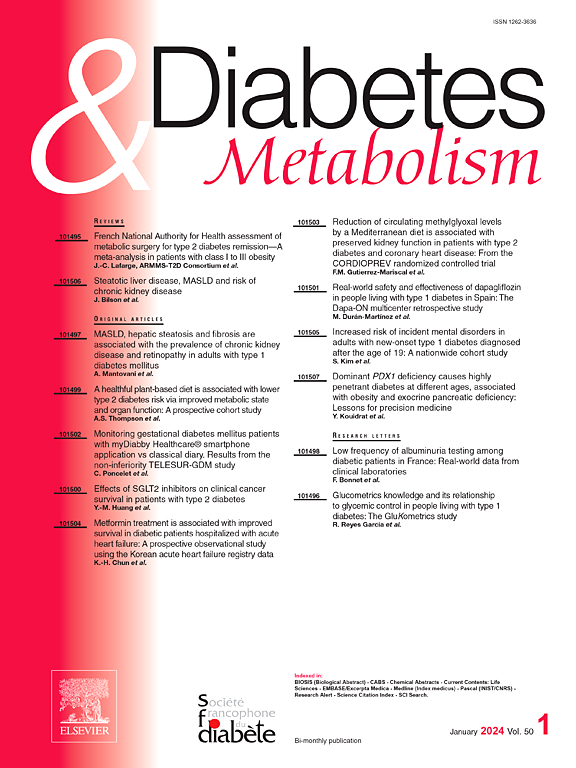邻苯二甲酸盐暴露、生物老化和胰岛素抵抗、前驱糖尿病和糖尿病的风险增加与代谢功能障碍相关的成人脂肪变性肝病
IF 4.7
2区 医学
Q1 ENDOCRINOLOGY & METABOLISM
引用次数: 0
摘要
目的:评估邻苯二甲酸酯和生物衰老对代谢功能障碍相关脂肪变性肝病(MASLD)人群胰岛素抵抗(IR)、前驱糖尿病和糖尿病的个体和联合影响。方法:收集3045名美国MASLD成年患者的数据,通过调查加权logistic回归和加权分位数和(WQS)回归,概述尿邻苯二甲酸酯代谢物对流行IR、前驱糖尿病和糖尿病的个体和混合影响,以及邻苯二甲酸酯与生物衰老之间的相互作用。结果:我们发现邻苯二甲酸单-2-乙基-5-羧基戊基酯[1.041;1.264]、邻苯二甲酸单-(2-乙基-5-羟基己基)酯1.175[1.073;1.288]、邻苯二甲酸单-(2-乙基-5-氧己基)酯1.140[1.040;1.250]与IR呈正相关,邻苯二甲酸单异丁酯与前驱糖尿病1.216[1.064;1.390]呈正相关(所有经fdr调整的p相互作用 = 0.031)、前驱糖尿病1.975 [1.189;3.278](p相互作用 = 0.009)、糖尿病6.065[3.210;11.460](p相互作用 = 0.013)。结论:MASLD成人邻苯二甲酸盐暴露与IR、前驱糖尿病和糖尿病的风险增加有关,并与生物衰老相互作用加重。控制邻苯二甲酸盐暴露和生物老化可能与MASLD人群中糖尿病的预防具有重要意义。本文章由计算机程序翻译,如有差异,请以英文原文为准。
Phthalates exposure, biological aging, and increased risks of insulin resistance, prediabetes, and diabetes in adults with metabolic dysfunction-associated steatotic liver disease
Aim
To estimate the individual and combined influences of phthalates and biological aging on insulin resistance (IR), prediabetes, and diabetes in population with metabolic dysfunction-associated steatotic liver disease (MASLD).
Methods
Data on 3,045 US adults with MASLD were collected to outline the individual and mixed effects of urinary phthalate metabolites on prevalent IR, prediabetes, and diabetes by survey-weighted logistic regression and weighted quantile sum (WQS) regression, as well as the interaction effects between phthalates and biological aging.
Results
We discovered positive relationships – odds ratio (OR) and 95 % confidence interval [CI] – of mono-2-ethyl-5-carboxypentyl phthalate 1.147 [1.041;1.264], mono-(2-ethyl-5-hydroxyhexyl) phthalate 1.175 [1.073;1.288], and mono-(2-ethyl-5-oxohexyl) phthalate 1.140 [1.040;1.250] with IR, and of mono-isobutyl phthalate with prediabetes 1.216 [1.064;1.390] (all FDR-adjusted P < 0.05). WQS analyses indicated significantly mixed effects of phthalate metabolites on the elevated risks of IR 1.166 [1.034;1.315], prediabetes 1.194 [1.006;1.416], and diabetes 1.214 [1.026;1.437]. Biological age (BA) and phenotypic age (PA) were positively associated with IR, prediabetes, and diabetes and further significantly interacted with phthalates on the outcomes; typically, compared to participants with low levels of phthalates mixture and PA, those with high levels of phthalates mixture and PA had the highest risks of IR 2.468 [1.474;4.133] (Pinteraction = 0.031), prediabetes 1.975 [1.189;3.278] (Pinteraction = 0.009), and diabetes 6.065 [3.210;11.460] (Pinteraction = 0.013).
Conclusion
Phthalates exposure of MASLD adults was related to increased risks of IR, prediabetes, and diabetes, which were interactively aggravated by biological aging. Controlling phthalates exposure and biological aging probably hold significant relevance for the prevention of diabetes in the MASLD population.
求助全文
通过发布文献求助,成功后即可免费获取论文全文。
去求助
来源期刊

Diabetes & metabolism
医学-内分泌学与代谢
CiteScore
12.00
自引率
4.20%
发文量
86
审稿时长
13 days
期刊介绍:
A high quality scientific journal with an international readership
Official publication of the SFD, Diabetes & Metabolism, publishes high-quality papers by leading teams, forming a close link between hospital and research units. Diabetes & Metabolism is published in English language and is indexed in all major databases with its impact factor constantly progressing.
Diabetes & Metabolism contains original articles, short reports and comprehensive reviews.
 求助内容:
求助内容: 应助结果提醒方式:
应助结果提醒方式:


